Nursing Care of Jamir: Asthma Case Study and Family Involvement
VerifiedAdded on 2020/10/05
|8
|2649
|227
Case Study
AI Summary
This case study examines the nursing care of Jamir, an 8-year-old boy with asthma, focusing on his care needs, nursing priorities, and the importance of family involvement. The analysis includes an assessment of Jamir's health status, identifying respiratory resuscitation as a key nursing priority, and strategies to ensure the participation of the patient and his family in the care plan. The study emphasizes the need for a family-centered approach, especially considering Jamir's young age and his mother's depression, highlighting the impact of family support on the effectiveness of the care plan. The case study outlines interventions to achieve nursing goals, such as clear airways and proper breathing techniques, and provides a care plan with specific nursing goals, interventions, and evaluation methods. The conclusion emphasizes the significance of family-centered strategies, particularly in pediatric cases, to enhance the quality of care and achieve desired health outcomes.

CASE STUDY
Paraphrase This Document
Need a fresh take? Get an instant paraphrase of this document with our AI Paraphraser
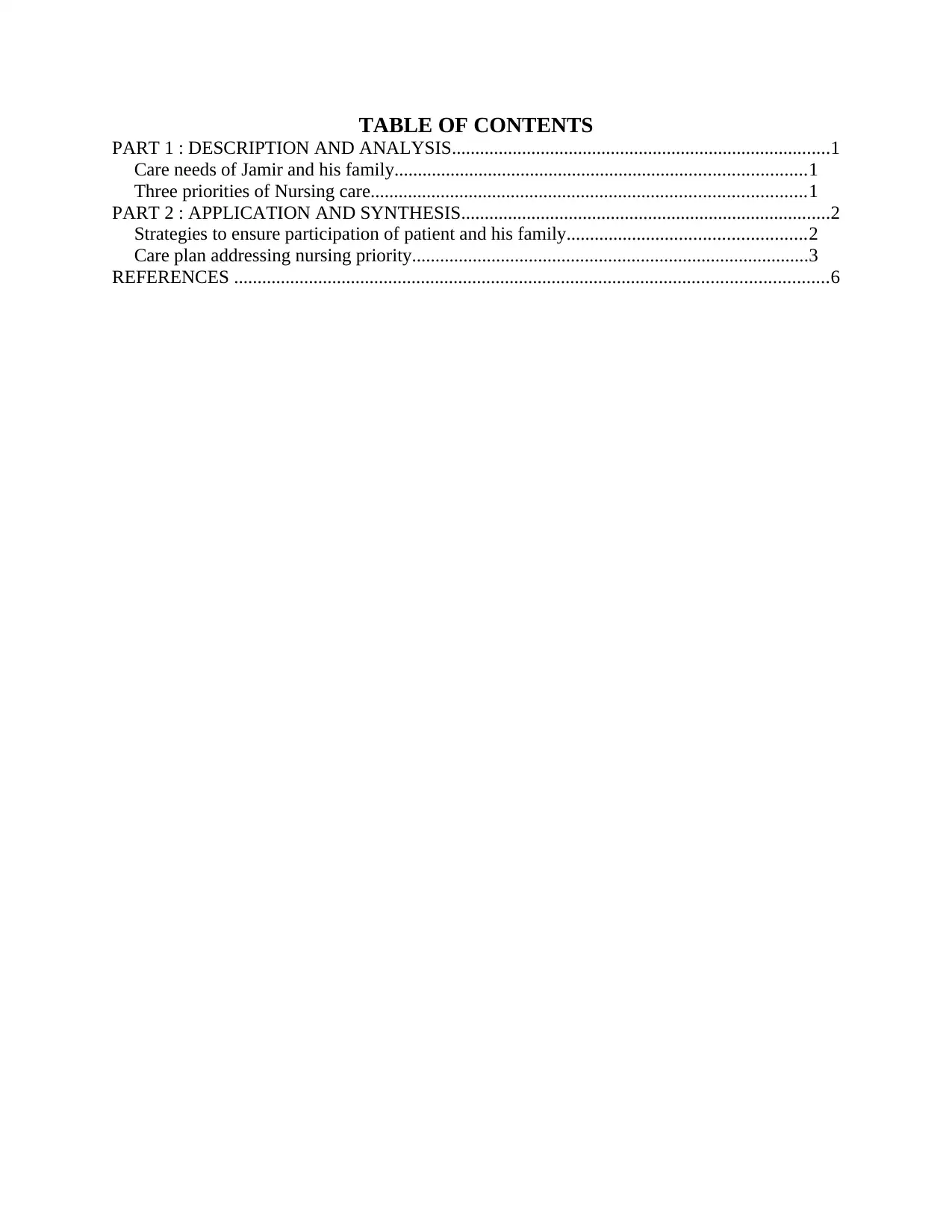
TABLE OF CONTENTS
PART 1 : DESCRIPTION AND ANALYSIS.................................................................................1
Care needs of Jamir and his family........................................................................................1
Three priorities of Nursing care.............................................................................................1
PART 2 : APPLICATION AND SYNTHESIS...............................................................................2
Strategies to ensure participation of patient and his family...................................................2
Care plan addressing nursing priority.....................................................................................3
REFERENCES ...............................................................................................................................6
PART 1 : DESCRIPTION AND ANALYSIS.................................................................................1
Care needs of Jamir and his family........................................................................................1
Three priorities of Nursing care.............................................................................................1
PART 2 : APPLICATION AND SYNTHESIS...............................................................................2
Strategies to ensure participation of patient and his family...................................................2
Care plan addressing nursing priority.....................................................................................3
REFERENCES ...............................................................................................................................6
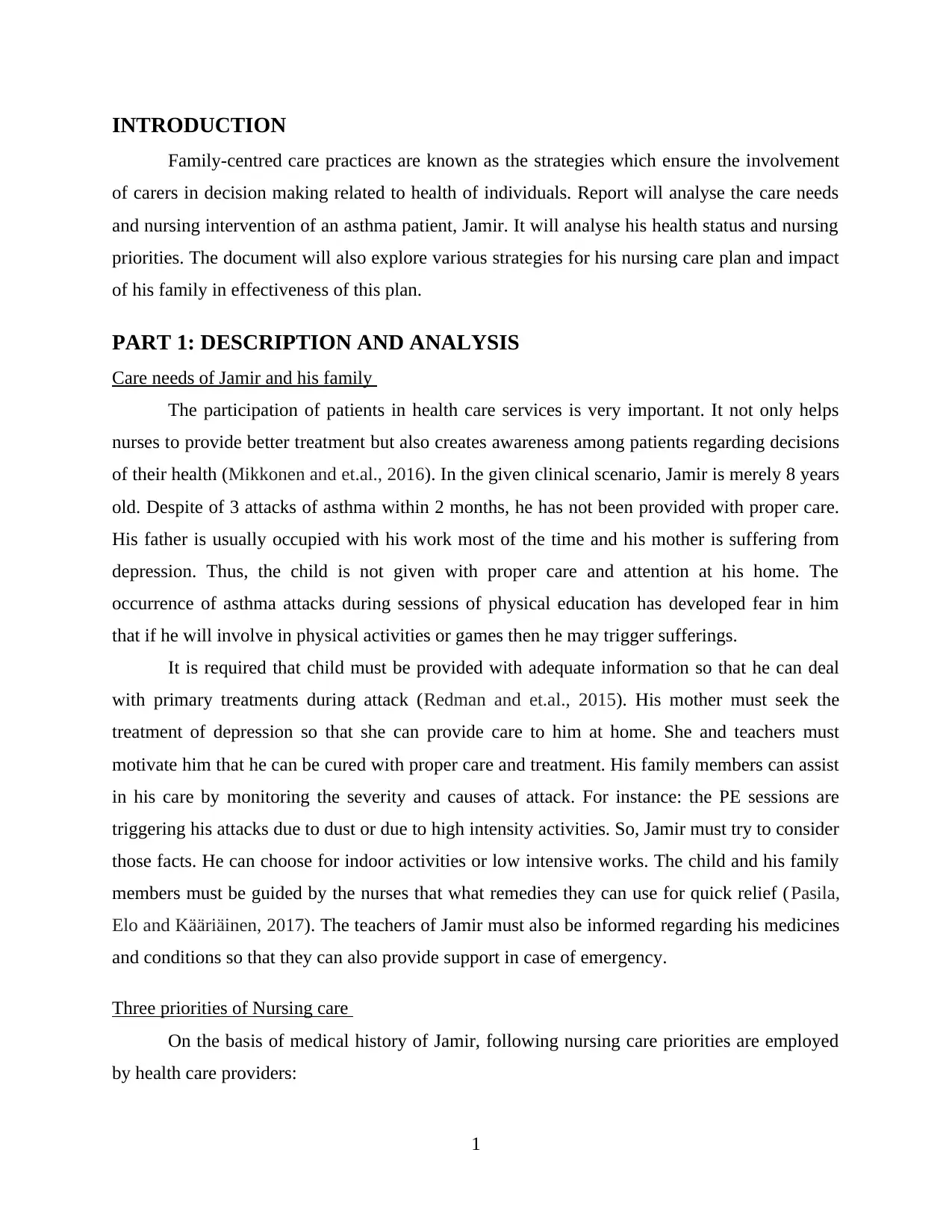
INTRODUCTION
Family-centred care practices are known as the strategies which ensure the involvement
of carers in decision making related to health of individuals. Report will analyse the care needs
and nursing intervention of an asthma patient, Jamir. It will analyse his health status and nursing
priorities. The document will also explore various strategies for his nursing care plan and impact
of his family in effectiveness of this plan.
PART 1: DESCRIPTION AND ANALYSIS
Care needs of Jamir and his family
The participation of patients in health care services is very important. It not only helps
nurses to provide better treatment but also creates awareness among patients regarding decisions
of their health (Mikkonen and et.al., 2016). In the given clinical scenario, Jamir is merely 8 years
old. Despite of 3 attacks of asthma within 2 months, he has not been provided with proper care.
His father is usually occupied with his work most of the time and his mother is suffering from
depression. Thus, the child is not given with proper care and attention at his home. The
occurrence of asthma attacks during sessions of physical education has developed fear in him
that if he will involve in physical activities or games then he may trigger sufferings.
It is required that child must be provided with adequate information so that he can deal
with primary treatments during attack (Redman and et.al., 2015). His mother must seek the
treatment of depression so that she can provide care to him at home. She and teachers must
motivate him that he can be cured with proper care and treatment. His family members can assist
in his care by monitoring the severity and causes of attack. For instance: the PE sessions are
triggering his attacks due to dust or due to high intensity activities. So, Jamir must try to consider
those facts. He can choose for indoor activities or low intensive works. The child and his family
members must be guided by the nurses that what remedies they can use for quick relief ( Pasila,
Elo and Kääriäinen, 2017). The teachers of Jamir must also be informed regarding his medicines
and conditions so that they can also provide support in case of emergency.
Three priorities of Nursing care
On the basis of medical history of Jamir, following nursing care priorities are employed
by health care providers:
1
Family-centred care practices are known as the strategies which ensure the involvement
of carers in decision making related to health of individuals. Report will analyse the care needs
and nursing intervention of an asthma patient, Jamir. It will analyse his health status and nursing
priorities. The document will also explore various strategies for his nursing care plan and impact
of his family in effectiveness of this plan.
PART 1: DESCRIPTION AND ANALYSIS
Care needs of Jamir and his family
The participation of patients in health care services is very important. It not only helps
nurses to provide better treatment but also creates awareness among patients regarding decisions
of their health (Mikkonen and et.al., 2016). In the given clinical scenario, Jamir is merely 8 years
old. Despite of 3 attacks of asthma within 2 months, he has not been provided with proper care.
His father is usually occupied with his work most of the time and his mother is suffering from
depression. Thus, the child is not given with proper care and attention at his home. The
occurrence of asthma attacks during sessions of physical education has developed fear in him
that if he will involve in physical activities or games then he may trigger sufferings.
It is required that child must be provided with adequate information so that he can deal
with primary treatments during attack (Redman and et.al., 2015). His mother must seek the
treatment of depression so that she can provide care to him at home. She and teachers must
motivate him that he can be cured with proper care and treatment. His family members can assist
in his care by monitoring the severity and causes of attack. For instance: the PE sessions are
triggering his attacks due to dust or due to high intensity activities. So, Jamir must try to consider
those facts. He can choose for indoor activities or low intensive works. The child and his family
members must be guided by the nurses that what remedies they can use for quick relief ( Pasila,
Elo and Kääriäinen, 2017). The teachers of Jamir must also be informed regarding his medicines
and conditions so that they can also provide support in case of emergency.
Three priorities of Nursing care
On the basis of medical history of Jamir, following nursing care priorities are employed
by health care providers:
1
⊘ This is a preview!⊘
Do you want full access?
Subscribe today to unlock all pages.

Trusted by 1+ million students worldwide
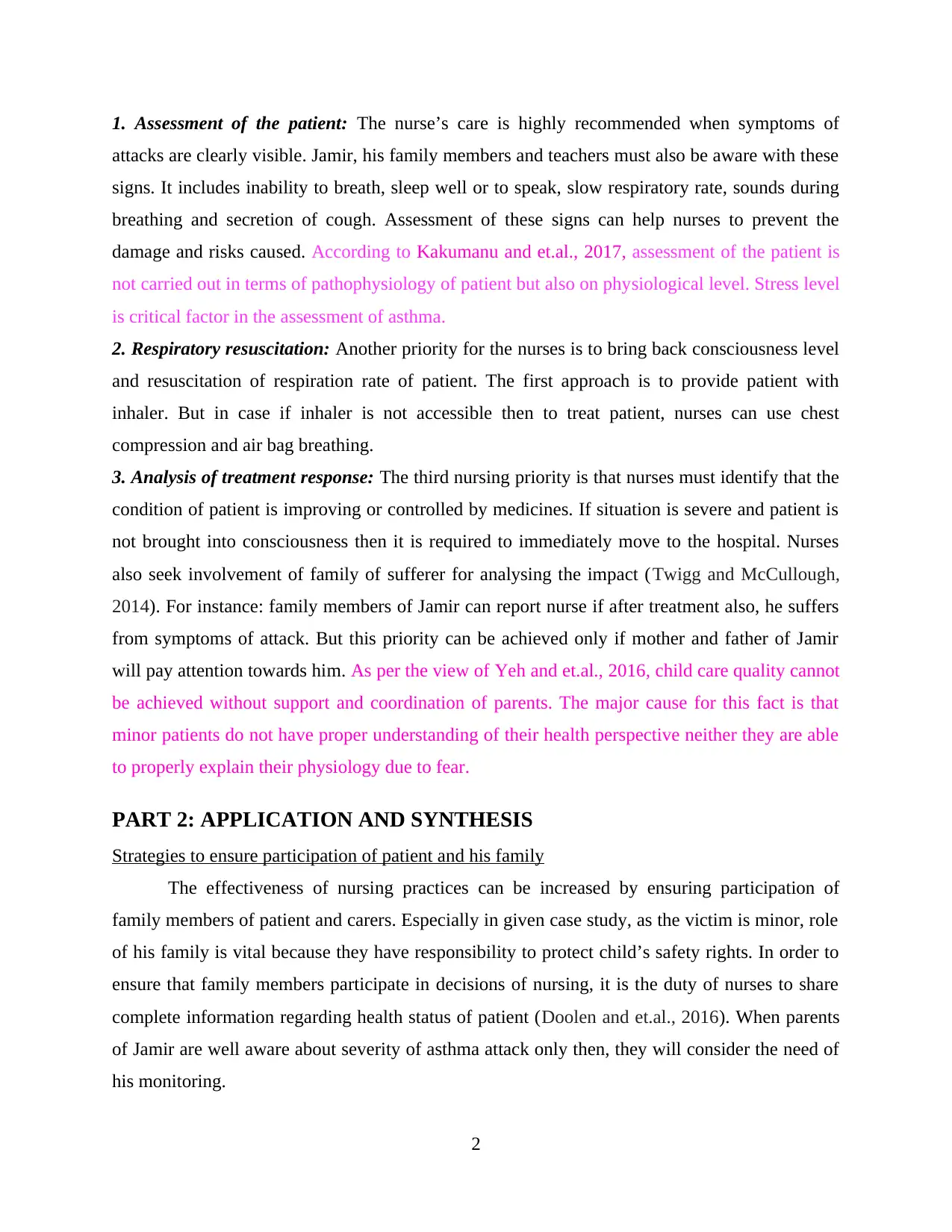
1. Assessment of the patient: The nurse’s care is highly recommended when symptoms of
attacks are clearly visible. Jamir, his family members and teachers must also be aware with these
signs. It includes inability to breath, sleep well or to speak, slow respiratory rate, sounds during
breathing and secretion of cough. Assessment of these signs can help nurses to prevent the
damage and risks caused. According to Kakumanu and et.al., 2017, assessment of the patient is
not carried out in terms of pathophysiology of patient but also on physiological level. Stress level
is critical factor in the assessment of asthma.
2. Respiratory resuscitation: Another priority for the nurses is to bring back consciousness level
and resuscitation of respiration rate of patient. The first approach is to provide patient with
inhaler. But in case if inhaler is not accessible then to treat patient, nurses can use chest
compression and air bag breathing.
3. Analysis of treatment response: The third nursing priority is that nurses must identify that the
condition of patient is improving or controlled by medicines. If situation is severe and patient is
not brought into consciousness then it is required to immediately move to the hospital. Nurses
also seek involvement of family of sufferer for analysing the impact (Twigg and McCullough,
2014). For instance: family members of Jamir can report nurse if after treatment also, he suffers
from symptoms of attack. But this priority can be achieved only if mother and father of Jamir
will pay attention towards him. As per the view of Yeh and et.al., 2016, child care quality cannot
be achieved without support and coordination of parents. The major cause for this fact is that
minor patients do not have proper understanding of their health perspective neither they are able
to properly explain their physiology due to fear.
PART 2: APPLICATION AND SYNTHESIS
Strategies to ensure participation of patient and his family
The effectiveness of nursing practices can be increased by ensuring participation of
family members of patient and carers. Especially in given case study, as the victim is minor, role
of his family is vital because they have responsibility to protect child’s safety rights. In order to
ensure that family members participate in decisions of nursing, it is the duty of nurses to share
complete information regarding health status of patient (Doolen and et.al., 2016). When parents
of Jamir are well aware about severity of asthma attack only then, they will consider the need of
his monitoring.
2
attacks are clearly visible. Jamir, his family members and teachers must also be aware with these
signs. It includes inability to breath, sleep well or to speak, slow respiratory rate, sounds during
breathing and secretion of cough. Assessment of these signs can help nurses to prevent the
damage and risks caused. According to Kakumanu and et.al., 2017, assessment of the patient is
not carried out in terms of pathophysiology of patient but also on physiological level. Stress level
is critical factor in the assessment of asthma.
2. Respiratory resuscitation: Another priority for the nurses is to bring back consciousness level
and resuscitation of respiration rate of patient. The first approach is to provide patient with
inhaler. But in case if inhaler is not accessible then to treat patient, nurses can use chest
compression and air bag breathing.
3. Analysis of treatment response: The third nursing priority is that nurses must identify that the
condition of patient is improving or controlled by medicines. If situation is severe and patient is
not brought into consciousness then it is required to immediately move to the hospital. Nurses
also seek involvement of family of sufferer for analysing the impact (Twigg and McCullough,
2014). For instance: family members of Jamir can report nurse if after treatment also, he suffers
from symptoms of attack. But this priority can be achieved only if mother and father of Jamir
will pay attention towards him. As per the view of Yeh and et.al., 2016, child care quality cannot
be achieved without support and coordination of parents. The major cause for this fact is that
minor patients do not have proper understanding of their health perspective neither they are able
to properly explain their physiology due to fear.
PART 2: APPLICATION AND SYNTHESIS
Strategies to ensure participation of patient and his family
The effectiveness of nursing practices can be increased by ensuring participation of
family members of patient and carers. Especially in given case study, as the victim is minor, role
of his family is vital because they have responsibility to protect child’s safety rights. In order to
ensure that family members participate in decisions of nursing, it is the duty of nurses to share
complete information regarding health status of patient (Doolen and et.al., 2016). When parents
of Jamir are well aware about severity of asthma attack only then, they will consider the need of
his monitoring.
2
Paraphrase This Document
Need a fresh take? Get an instant paraphrase of this document with our AI Paraphraser
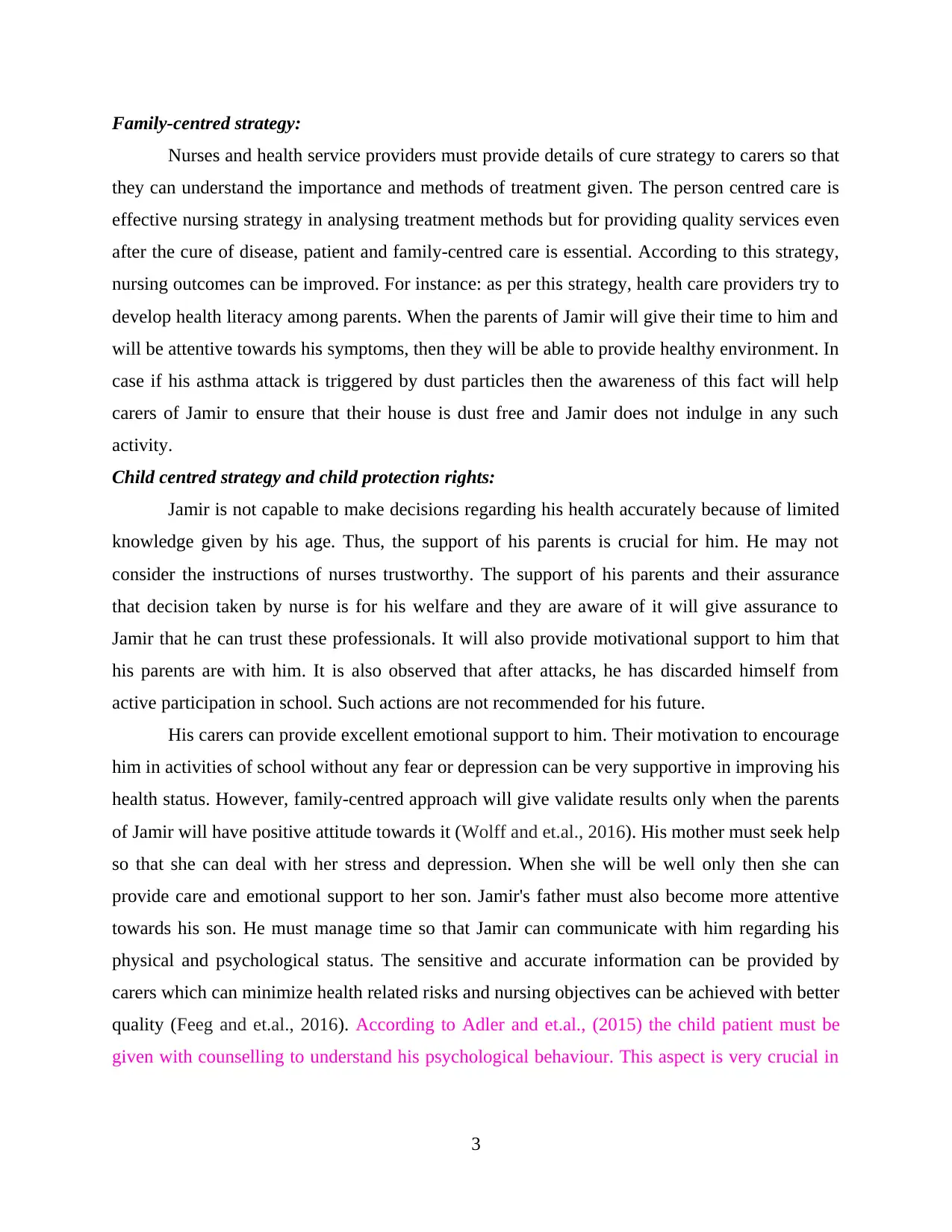
Family-centred strategy:
Nurses and health service providers must provide details of cure strategy to carers so that
they can understand the importance and methods of treatment given. The person centred care is
effective nursing strategy in analysing treatment methods but for providing quality services even
after the cure of disease, patient and family-centred care is essential. According to this strategy,
nursing outcomes can be improved. For instance: as per this strategy, health care providers try to
develop health literacy among parents. When the parents of Jamir will give their time to him and
will be attentive towards his symptoms, then they will be able to provide healthy environment. In
case if his asthma attack is triggered by dust particles then the awareness of this fact will help
carers of Jamir to ensure that their house is dust free and Jamir does not indulge in any such
activity.
Child centred strategy and child protection rights:
Jamir is not capable to make decisions regarding his health accurately because of limited
knowledge given by his age. Thus, the support of his parents is crucial for him. He may not
consider the instructions of nurses trustworthy. The support of his parents and their assurance
that decision taken by nurse is for his welfare and they are aware of it will give assurance to
Jamir that he can trust these professionals. It will also provide motivational support to him that
his parents are with him. It is also observed that after attacks, he has discarded himself from
active participation in school. Such actions are not recommended for his future.
His carers can provide excellent emotional support to him. Their motivation to encourage
him in activities of school without any fear or depression can be very supportive in improving his
health status. However, family-centred approach will give validate results only when the parents
of Jamir will have positive attitude towards it (Wolff and et.al., 2016). His mother must seek help
so that she can deal with her stress and depression. When she will be well only then she can
provide care and emotional support to her son. Jamir's father must also become more attentive
towards his son. He must manage time so that Jamir can communicate with him regarding his
physical and psychological status. The sensitive and accurate information can be provided by
carers which can minimize health related risks and nursing objectives can be achieved with better
quality (Feeg and et.al., 2016). According to Adler and et.al., (2015) the child patient must be
given with counselling to understand his psychological behaviour. This aspect is very crucial in
3
Nurses and health service providers must provide details of cure strategy to carers so that
they can understand the importance and methods of treatment given. The person centred care is
effective nursing strategy in analysing treatment methods but for providing quality services even
after the cure of disease, patient and family-centred care is essential. According to this strategy,
nursing outcomes can be improved. For instance: as per this strategy, health care providers try to
develop health literacy among parents. When the parents of Jamir will give their time to him and
will be attentive towards his symptoms, then they will be able to provide healthy environment. In
case if his asthma attack is triggered by dust particles then the awareness of this fact will help
carers of Jamir to ensure that their house is dust free and Jamir does not indulge in any such
activity.
Child centred strategy and child protection rights:
Jamir is not capable to make decisions regarding his health accurately because of limited
knowledge given by his age. Thus, the support of his parents is crucial for him. He may not
consider the instructions of nurses trustworthy. The support of his parents and their assurance
that decision taken by nurse is for his welfare and they are aware of it will give assurance to
Jamir that he can trust these professionals. It will also provide motivational support to him that
his parents are with him. It is also observed that after attacks, he has discarded himself from
active participation in school. Such actions are not recommended for his future.
His carers can provide excellent emotional support to him. Their motivation to encourage
him in activities of school without any fear or depression can be very supportive in improving his
health status. However, family-centred approach will give validate results only when the parents
of Jamir will have positive attitude towards it (Wolff and et.al., 2016). His mother must seek help
so that she can deal with her stress and depression. When she will be well only then she can
provide care and emotional support to her son. Jamir's father must also become more attentive
towards his son. He must manage time so that Jamir can communicate with him regarding his
physical and psychological status. The sensitive and accurate information can be provided by
carers which can minimize health related risks and nursing objectives can be achieved with better
quality (Feeg and et.al., 2016). According to Adler and et.al., (2015) the child patient must be
given with counselling to understand his psychological behaviour. This aspect is very crucial in
3
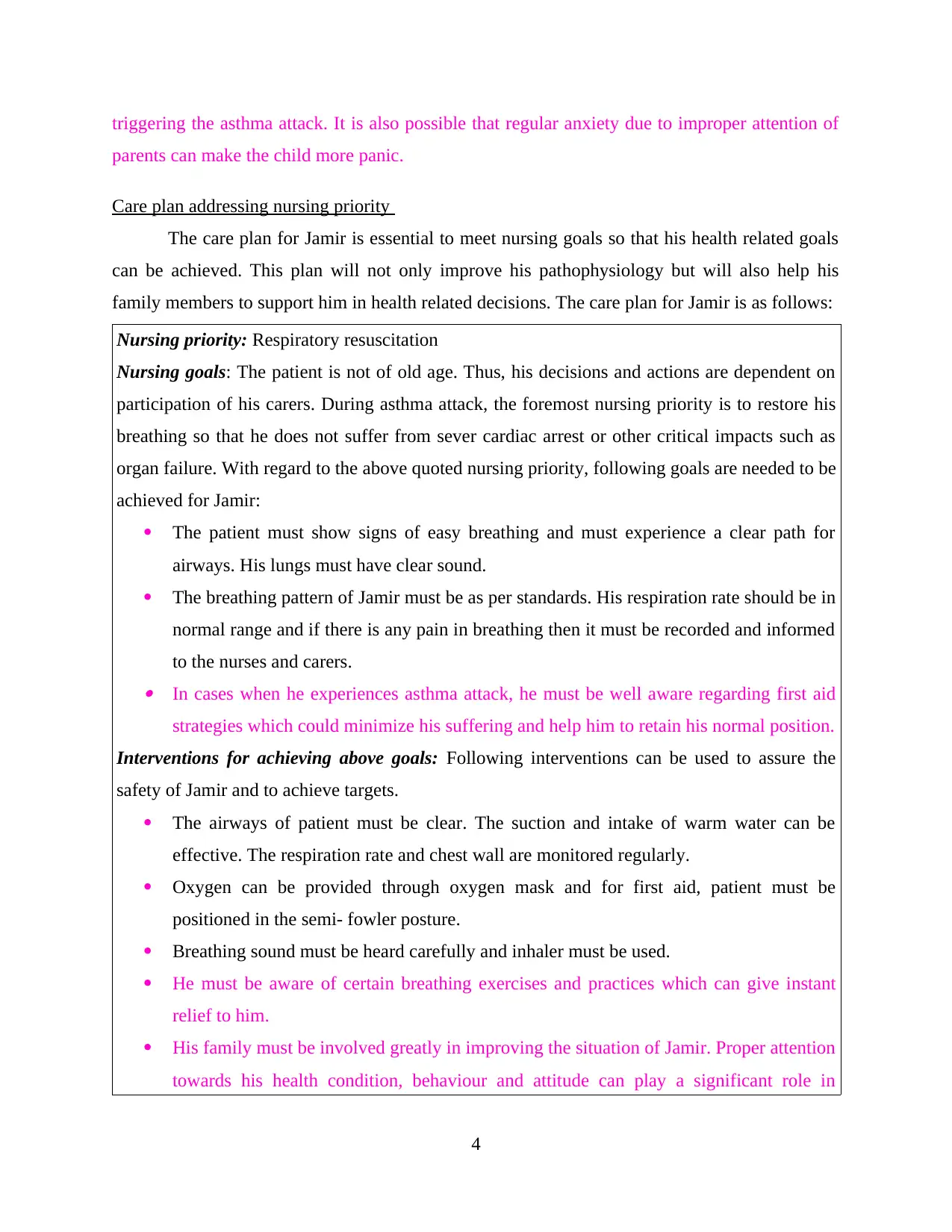
triggering the asthma attack. It is also possible that regular anxiety due to improper attention of
parents can make the child more panic.
Care plan addressing nursing priority
The care plan for Jamir is essential to meet nursing goals so that his health related goals
can be achieved. This plan will not only improve his pathophysiology but will also help his
family members to support him in health related decisions. The care plan for Jamir is as follows:
Nursing priority: Respiratory resuscitation
Nursing goals: The patient is not of old age. Thus, his decisions and actions are dependent on
participation of his carers. During asthma attack, the foremost nursing priority is to restore his
breathing so that he does not suffer from sever cardiac arrest or other critical impacts such as
organ failure. With regard to the above quoted nursing priority, following goals are needed to be
achieved for Jamir:
The patient must show signs of easy breathing and must experience a clear path for
airways. His lungs must have clear sound.
The breathing pattern of Jamir must be as per standards. His respiration rate should be in
normal range and if there is any pain in breathing then it must be recorded and informed
to the nurses and carers. In cases when he experiences asthma attack, he must be well aware regarding first aid
strategies which could minimize his suffering and help him to retain his normal position.
Interventions for achieving above goals: Following interventions can be used to assure the
safety of Jamir and to achieve targets.
The airways of patient must be clear. The suction and intake of warm water can be
effective. The respiration rate and chest wall are monitored regularly.
Oxygen can be provided through oxygen mask and for first aid, patient must be
positioned in the semi- fowler posture.
Breathing sound must be heard carefully and inhaler must be used.
He must be aware of certain breathing exercises and practices which can give instant
relief to him.
His family must be involved greatly in improving the situation of Jamir. Proper attention
towards his health condition, behaviour and attitude can play a significant role in
4
parents can make the child more panic.
Care plan addressing nursing priority
The care plan for Jamir is essential to meet nursing goals so that his health related goals
can be achieved. This plan will not only improve his pathophysiology but will also help his
family members to support him in health related decisions. The care plan for Jamir is as follows:
Nursing priority: Respiratory resuscitation
Nursing goals: The patient is not of old age. Thus, his decisions and actions are dependent on
participation of his carers. During asthma attack, the foremost nursing priority is to restore his
breathing so that he does not suffer from sever cardiac arrest or other critical impacts such as
organ failure. With regard to the above quoted nursing priority, following goals are needed to be
achieved for Jamir:
The patient must show signs of easy breathing and must experience a clear path for
airways. His lungs must have clear sound.
The breathing pattern of Jamir must be as per standards. His respiration rate should be in
normal range and if there is any pain in breathing then it must be recorded and informed
to the nurses and carers. In cases when he experiences asthma attack, he must be well aware regarding first aid
strategies which could minimize his suffering and help him to retain his normal position.
Interventions for achieving above goals: Following interventions can be used to assure the
safety of Jamir and to achieve targets.
The airways of patient must be clear. The suction and intake of warm water can be
effective. The respiration rate and chest wall are monitored regularly.
Oxygen can be provided through oxygen mask and for first aid, patient must be
positioned in the semi- fowler posture.
Breathing sound must be heard carefully and inhaler must be used.
He must be aware of certain breathing exercises and practices which can give instant
relief to him.
His family must be involved greatly in improving the situation of Jamir. Proper attention
towards his health condition, behaviour and attitude can play a significant role in
4
⊘ This is a preview!⊘
Do you want full access?
Subscribe today to unlock all pages.

Trusted by 1+ million students worldwide
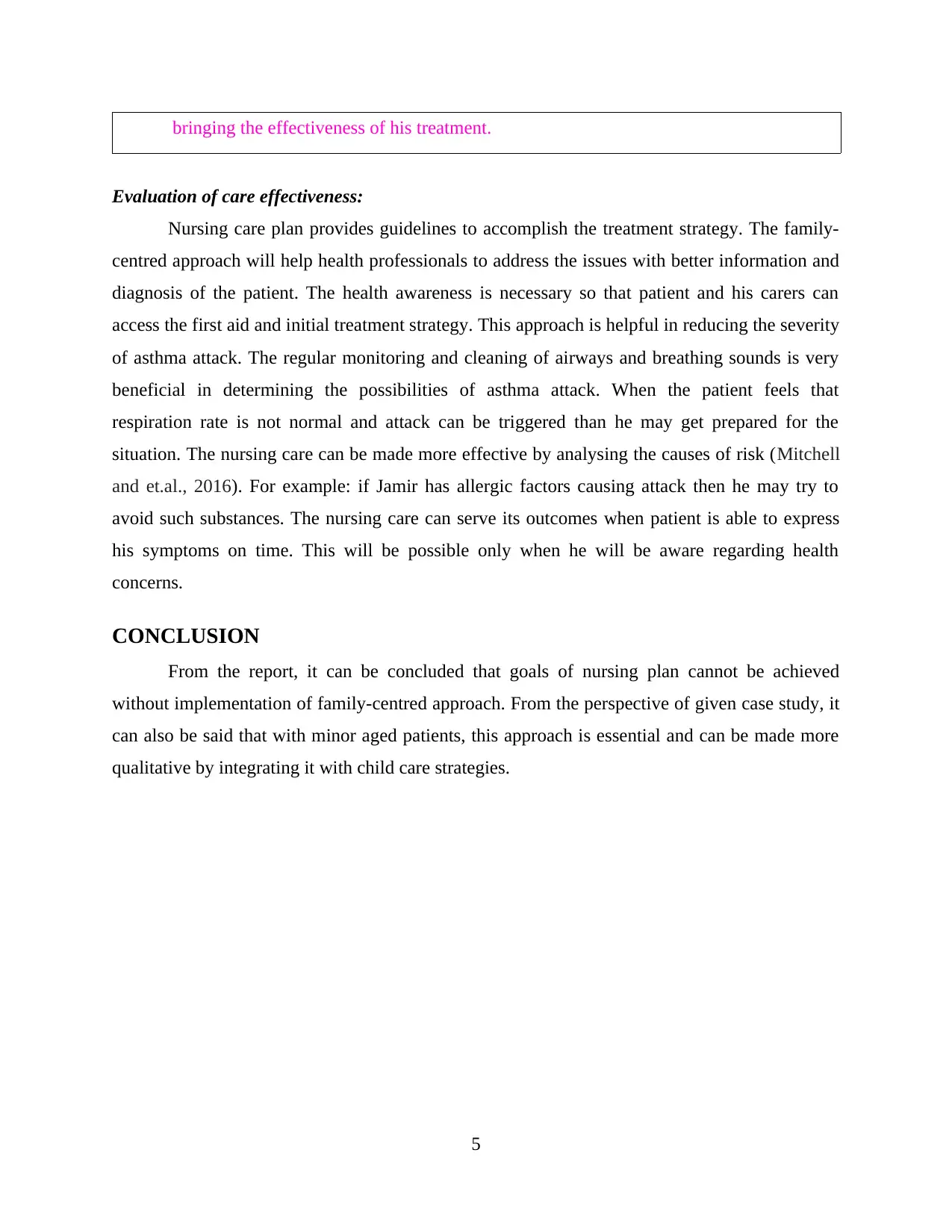
bringing the effectiveness of his treatment.
Evaluation of care effectiveness:
Nursing care plan provides guidelines to accomplish the treatment strategy. The family-
centred approach will help health professionals to address the issues with better information and
diagnosis of the patient. The health awareness is necessary so that patient and his carers can
access the first aid and initial treatment strategy. This approach is helpful in reducing the severity
of asthma attack. The regular monitoring and cleaning of airways and breathing sounds is very
beneficial in determining the possibilities of asthma attack. When the patient feels that
respiration rate is not normal and attack can be triggered than he may get prepared for the
situation. The nursing care can be made more effective by analysing the causes of risk (Mitchell
and et.al., 2016). For example: if Jamir has allergic factors causing attack then he may try to
avoid such substances. The nursing care can serve its outcomes when patient is able to express
his symptoms on time. This will be possible only when he will be aware regarding health
concerns.
CONCLUSION
From the report, it can be concluded that goals of nursing plan cannot be achieved
without implementation of family-centred approach. From the perspective of given case study, it
can also be said that with minor aged patients, this approach is essential and can be made more
qualitative by integrating it with child care strategies.
5
Evaluation of care effectiveness:
Nursing care plan provides guidelines to accomplish the treatment strategy. The family-
centred approach will help health professionals to address the issues with better information and
diagnosis of the patient. The health awareness is necessary so that patient and his carers can
access the first aid and initial treatment strategy. This approach is helpful in reducing the severity
of asthma attack. The regular monitoring and cleaning of airways and breathing sounds is very
beneficial in determining the possibilities of asthma attack. When the patient feels that
respiration rate is not normal and attack can be triggered than he may get prepared for the
situation. The nursing care can be made more effective by analysing the causes of risk (Mitchell
and et.al., 2016). For example: if Jamir has allergic factors causing attack then he may try to
avoid such substances. The nursing care can serve its outcomes when patient is able to express
his symptoms on time. This will be possible only when he will be aware regarding health
concerns.
CONCLUSION
From the report, it can be concluded that goals of nursing plan cannot be achieved
without implementation of family-centred approach. From the perspective of given case study, it
can also be said that with minor aged patients, this approach is essential and can be made more
qualitative by integrating it with child care strategies.
5
Paraphrase This Document
Need a fresh take? Get an instant paraphrase of this document with our AI Paraphraser
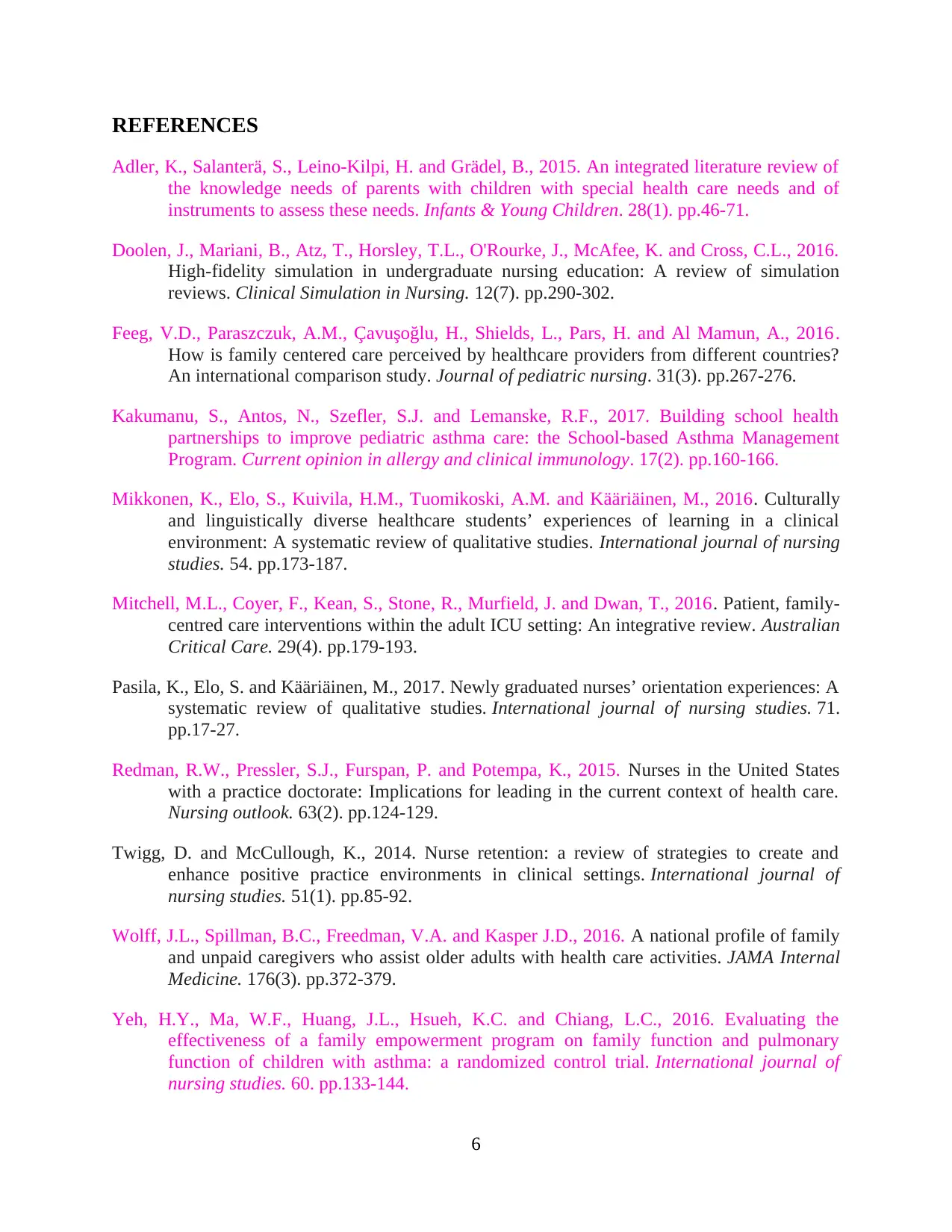
REFERENCES
Adler, K., Salanterä, S., Leino-Kilpi, H. and Grädel, B., 2015. An integrated literature review of
the knowledge needs of parents with children with special health care needs and of
instruments to assess these needs. Infants & Young Children. 28(1). pp.46-71.
Doolen, J., Mariani, B., Atz, T., Horsley, T.L., O'Rourke, J., McAfee, K. and Cross, C.L., 2016.
High-fidelity simulation in undergraduate nursing education: A review of simulation
reviews. Clinical Simulation in Nursing. 12(7). pp.290-302.
Feeg, V.D., Paraszczuk, A.M., Çavuşoğlu, H., Shields, L., Pars, H. and Al Mamun, A., 2016.
How is family centered care perceived by healthcare providers from different countries?
An international comparison study. Journal of pediatric nursing. 31(3). pp.267-276.
Kakumanu, S., Antos, N., Szefler, S.J. and Lemanske, R.F., 2017. Building school health
partnerships to improve pediatric asthma care: the School-based Asthma Management
Program. Current opinion in allergy and clinical immunology. 17(2). pp.160-166.
Mikkonen, K., Elo, S., Kuivila, H.M., Tuomikoski, A.M. and Kääriäinen, M., 2016. Culturally
and linguistically diverse healthcare students’ experiences of learning in a clinical
environment: A systematic review of qualitative studies. International journal of nursing
studies. 54. pp.173-187.
Mitchell, M.L., Coyer, F., Kean, S., Stone, R., Murfield, J. and Dwan, T., 2016. Patient, family-
centred care interventions within the adult ICU setting: An integrative review. Australian
Critical Care. 29(4). pp.179-193.
Pasila, K., Elo, S. and Kääriäinen, M., 2017. Newly graduated nurses’ orientation experiences: A
systematic review of qualitative studies. International journal of nursing studies. 71.
pp.17-27.
Redman, R.W., Pressler, S.J., Furspan, P. and Potempa, K., 2015. Nurses in the United States
with a practice doctorate: Implications for leading in the current context of health care.
Nursing outlook. 63(2). pp.124-129.
Twigg, D. and McCullough, K., 2014. Nurse retention: a review of strategies to create and
enhance positive practice environments in clinical settings. International journal of
nursing studies. 51(1). pp.85-92.
Wolff, J.L., Spillman, B.C., Freedman, V.A. and Kasper J.D., 2016. A national profile of family
and unpaid caregivers who assist older adults with health care activities. JAMA Internal
Medicine. 176(3). pp.372-379.
Yeh, H.Y., Ma, W.F., Huang, J.L., Hsueh, K.C. and Chiang, L.C., 2016. Evaluating the
effectiveness of a family empowerment program on family function and pulmonary
function of children with asthma: a randomized control trial. International journal of
nursing studies. 60. pp.133-144.
6
Adler, K., Salanterä, S., Leino-Kilpi, H. and Grädel, B., 2015. An integrated literature review of
the knowledge needs of parents with children with special health care needs and of
instruments to assess these needs. Infants & Young Children. 28(1). pp.46-71.
Doolen, J., Mariani, B., Atz, T., Horsley, T.L., O'Rourke, J., McAfee, K. and Cross, C.L., 2016.
High-fidelity simulation in undergraduate nursing education: A review of simulation
reviews. Clinical Simulation in Nursing. 12(7). pp.290-302.
Feeg, V.D., Paraszczuk, A.M., Çavuşoğlu, H., Shields, L., Pars, H. and Al Mamun, A., 2016.
How is family centered care perceived by healthcare providers from different countries?
An international comparison study. Journal of pediatric nursing. 31(3). pp.267-276.
Kakumanu, S., Antos, N., Szefler, S.J. and Lemanske, R.F., 2017. Building school health
partnerships to improve pediatric asthma care: the School-based Asthma Management
Program. Current opinion in allergy and clinical immunology. 17(2). pp.160-166.
Mikkonen, K., Elo, S., Kuivila, H.M., Tuomikoski, A.M. and Kääriäinen, M., 2016. Culturally
and linguistically diverse healthcare students’ experiences of learning in a clinical
environment: A systematic review of qualitative studies. International journal of nursing
studies. 54. pp.173-187.
Mitchell, M.L., Coyer, F., Kean, S., Stone, R., Murfield, J. and Dwan, T., 2016. Patient, family-
centred care interventions within the adult ICU setting: An integrative review. Australian
Critical Care. 29(4). pp.179-193.
Pasila, K., Elo, S. and Kääriäinen, M., 2017. Newly graduated nurses’ orientation experiences: A
systematic review of qualitative studies. International journal of nursing studies. 71.
pp.17-27.
Redman, R.W., Pressler, S.J., Furspan, P. and Potempa, K., 2015. Nurses in the United States
with a practice doctorate: Implications for leading in the current context of health care.
Nursing outlook. 63(2). pp.124-129.
Twigg, D. and McCullough, K., 2014. Nurse retention: a review of strategies to create and
enhance positive practice environments in clinical settings. International journal of
nursing studies. 51(1). pp.85-92.
Wolff, J.L., Spillman, B.C., Freedman, V.A. and Kasper J.D., 2016. A national profile of family
and unpaid caregivers who assist older adults with health care activities. JAMA Internal
Medicine. 176(3). pp.372-379.
Yeh, H.Y., Ma, W.F., Huang, J.L., Hsueh, K.C. and Chiang, L.C., 2016. Evaluating the
effectiveness of a family empowerment program on family function and pulmonary
function of children with asthma: a randomized control trial. International journal of
nursing studies. 60. pp.133-144.
6
1 out of 8
Related Documents
Your All-in-One AI-Powered Toolkit for Academic Success.
+13062052269
info@desklib.com
Available 24*7 on WhatsApp / Email
![[object Object]](/_next/static/media/star-bottom.7253800d.svg)
Unlock your academic potential
Copyright © 2020–2025 A2Z Services. All Rights Reserved. Developed and managed by ZUCOL.





